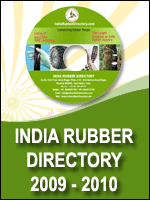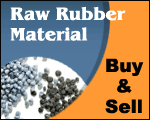Latex products for Health Care-Influence of Compounding
and Process variables on their Quality
D. Joseph Francis
Emeritus Scientist CSIR, Hindustan Latex Ltd
Akkulam, Trivandrum-695017.
Use of natural rubber latex condom as a contraceptive is widely accepted for
family planning and hence for the control of population. In the context of
increasing incidence of the incurable disease (AIDS), apart from abstinence, the
use of high quality condoms is the only healthy way to prevent or reduce the
risk of being infected with HIV the causative virus of the disease. The effect
or compounding variables and process parameters which significantly affect the
pinhole formation and physical properties of condoms, a typical health care
latex product, have been studied in detail (1) and the important results are
summarized here below. The general finding of this study are application to
quality improvement of other rubber products also.
Stabilizer system:
Addition of small amounts of higher fatty acid soaps have been shown to
greatly improve the mechanical stability of latex, with an optimum effect when
the alkyl chain length of the HFA soap contains 9 to 11 carbon atoms (2,3).
Among the six stabilizer systems studied, casein-potassium laurate system was
found to be most suitable for condom manufacture. This system gives lower
rejection percentage due to pinholes and are able to improve physical properties
of condoms. Tensile strength retention after ageing was maximum for this system.
Although elongation at break, modulus at 500% elongation, electrical resistance
etc. were comparable for all the systems, burst volume and burst pressure values
were higher for casein-potassium laurate system compared to casein-potassium
oleate which was the control. The lower rejection rate of compounds containing
potassium laurate compared to potassium oleate could be attributed to the lower
frothing tendency and improved mechanical stability caused by the laurate soap
(4).
Vulcanising system:
Vulcanising system is the most important compounding variable which could
affect the physical properties and ageing characteristics of condoms. Influence
of sulphur concentration in the formulation was studied keeping all other
parameters constant. It was found that tensile strength, elongation at a break,
modulus etc increased but ageing resistance was decreased. Burst volume and
burst pressure of condoms also increased inspite of the increase in modulus with
higher sulphur level. It is well known that in NR a high sulphur more flexible
and hence can cause higher elongation and tensile strength. However, these
polysulphidic crosslinks are more thermolabile and hence ageing resistance of
vulcanisates prepared using higher sulphur levels is poorer. The ageing
resistance could be improved by a judicious choice of acceleration system.
Setsit-NTP accelerator combination gave low ageing resistance whereas
Setsit-ZMBT combination improved the ageing resistance. Setsit-ZMBT combination
was found to give a tighter cure than Setsit-NTP and this was observed in the
burst pressure values also. The higher retention of tensile properties, burst
volume and burst pressure of compounds containing ZMBT may be due to the
antioxidant activity of ZMBT. NTP-ZMBT combination also gave higher tensile
strength, and modulus but burst volume and burst pressure were lower. Ageing
resistance was better than the control system, but was not as good as the
Setsit-ZMBT combination. When the concentrtion of ZMBT was higher in NTP-ZMBT
combination it gave increased values for burst volume modulus and tensile
strength. A combination of 0.5 phr of ZMBT and 0.3 phr of NTP was found to be
optimum for this system. The low mechanical strength of condoms when
dithiocarbamate type accelerators alone were used could be attributed to the
peaky cure exhibited by them which causes reversion of vulcanisates even under
slight overcuring conditions. Thiazole type are reported togive flatter cure
curves (5) than most other types of accelerators. They maintain properties even
when considerably overcured. Hence it is desirable to use combination of
thiazole type and a dithiocarbamate type accelerator for condom manufacture.
Antioxidants:
An antioxidant is essential to retain the properties of condoms after ageing
six antioxidants were examined Vulkanox HS, the amine type antioxidant used was
efficient in retaining the properties when added at 0.5 phr and above this
level. But higher concentrations were having a discolouring effect. Pentaflex SP
which is a phenolic antioxidant also was efficient at 1 phr level to impart
comparable tensile strength and brust volume. But the ageing characteristics
were much lower compared to Nocrac NS-5 which was the control.
Vanox MBPC and Nocrac NS-5 both bisphenolic type antioxidants were having
similar structure and hence same antioxidant efficiency. Vanox MBPC was
effective in imparting maximum values of modules at 0.5 phr level whereas Nocrac
NS-5 gave the maximum values at 0.75 phr level only. Tensile strength, burst
volume and burst pressure values and their retention after ageing increased
gradually with increasing concentration of these antioxidants. Ortholinked
bisphenols are reported to be more effective than paralinked analogues. The
higher retention properties such as burst volume, burst pressure and tensile
properties after ageing of condoms may be attributed to this advantageous
ortholinkage in the two antioxidants, Nocrac NS-5 and Vanox MBPC. Colour
development also lower for ortholinked bisphenols.
Among the six antioxidants studied Irganox 1010 and Vanox SKT were having
maximum antioxidant efficiency. 0.5 phr of these antioxidants were able to
improve the burst volume, tensile strength and burst pressure of condoms than
all the other antioxidants. Both these antioxidants are esters of phenol
substituted acids. Combination of Pentaflex SP and Vanox SKT and that of
Vulkanox HS and Nocrac NS-5 were having synergistic effect in imparting better
ageing characteristics to condoms. The discolouring tendency of Vulkanox HS also
was reduced by replaying a part of it with Nocrac NS-5.
Process variables:
Ball milling time of dispersion was found to affect the pinhole formulation
of condoms. As the ball milling time increased, the particle size of solid
ingredients decreased gradually and at 72 hours of ball milling optimum was
obtained. Above this period, a slight increase in the size of particles was
observed and this may be due to the reagglomeration of dispersed particles.
Physical properties of condoms also was higher when lower particle size
dispersions were used for compounding it was reported (6) that size of sulphur
particles is of great importance for the crosslinking reaction. The high tensile
strength, modulus and burst volume obtained at 72h ball milling could be
attributed to the optimum level of crosslinking obtained by the fine particle
size dispersion of sulphur and other ingredients.
Temperature and concentration of mould cleaning soap solution also influences
the quality of condoms. A higher than optimum level of soap may lead to frothing
and pinhole formation. Optimum temperature of the mould washing solution may be
helpful in removing grease, oil etc from the surface of the mould. This if these
parameters were not optimum, presence of oily substances on the mould surfaces
may lead to the formation of weak spots or pinholes in condoms.
Period and temperature of prevulcanisation and final vulcanisation also
significantly influences the physical properties and rejection rate of condoms
due to pinholes. Brust volume and burst pressure were maximum at 6 hours of
prevulcanisation. Then it decreases with increasing period of prevulcanisation.
Pinhole rejection rate was found to increase with increasing temperature of
prevulcanisation. 500C was found optimum for obtaining higher modulus at 500%
elongation, burst volume and burst pressure. Ageing resistance also decreased
when the temperature of prevulcanistion was increased. The adverse effect at
higher period and temperature of prevulcanisation may be due to more air
entrapment, at higher viscosity, obtained during prevulcanisation. Breaking of
polysulphidic in linkages also might have started during ageing, which were
formed as a result of prolonged heating at low temperatures of prevulcanisation.
Final vulcanization temperature was found optimum at 700C when duration was kept
at 30 minutes. Still higher temperature of vulcanization was found to increase
the pinhole rejection rate. It is possiblet that the microlevel air bubbles
expand and burst at the higher temperatures leading to large number of pinholes.
Adverse effect on properties such as tensile strength and burst volume of
condoms at higher temperatures and longer periods of vulcanisation may be due to
reversion taking in presence of dithiocarbamate type accelerators. Hence the
temperature and period of prevulcanisation as well as final vulcanisation are
interrelated in determining the final quality of NR latex condoms.
Postvulcanised, Prevulcanised and Radiation vulcanized NR latex condoms:
Using LATZ latex, condoms were prepared in three different ways. Latex was
compounded and postvulcanised condoms were prepared in one case. In another case
the latex compound was given a prevulcanization before the dipping process.
Radiation vulcanization of latex was carried out in the third case. Rheological
characteristics at different temperature and shear rates, effect on pinhole
formation, influence of different stabilizer system and affect of the presence
of antioxidant in these studied. Thus a comparative evaluation of the three
modified lattices were carried out with respect to tensile properties, burst
volume, burst pressure and ageing characteristics of condoms.
Viscosity values were higher for radiation vulcanized and prevulcanised lattices
compared to post vulcanized latex. But the viscosity difference was higher at
low shear rates. But increase in temperature was found to decrease the
difference.
Pinhole rejection percentage was higher for post vulcanized latex and lowest for
RVNRL condoms. Absence of any compounding dispersion in RVNRL may be
contributing to the low pinhole formation rate. Presence of an additional
stabilizer, KOH, may also be contributing to the lower rejection due to
pinholes. But in the case of prevulcanised latex the froth might have escaped
while prolonged heating for 8 hours and this may be the reason for comparatively
low rejection rate due to pinholes of prevulcanised latex than postvulcanised.
Presence of a stabilizer system in all three lattices were found to increase the
quality of condoms with respect to low pinhole formation and higher physical
properties. Among the three stabilizer system studied, casein-potassium laurate
combination was most effective in reducing the pinhole formation and improving
the tensile and burst volume properties. Polyvintyl alcohol-casein system
increased the viscosity of latex compound and pinhole rejection percentage of
aged condoms was higher compared to unaged in presence of this stabilizer
system. Potassium oleate-casein system was inferior due to high pinhole
formation rate and lower physical properties compared to potassium laurate-casein
system. Hence casein-potassium laurate system was found suitable for condoms of
all the three types of latices.
With respect to tensile strength and burst volume of condoms of the three
lattices, postvulcanised condoms were superior over two types. RVNRL condoms
were having very low physical properties and this result is in agreement with
those of previous workers (6). Presence of nonrubber particles which effect the
fusion behaviour of latex may be a reason for their low strength. High heat
stability and mechanical stability of RVNRL indicate a low extent of
vulcanistion and this also may be contributing to the low physical properties.
Breaking of polysulphidic linkages formed during prevulcanisation latex. Low wet
gel strength of prevulcanised latex also may be contributing to the
comparatively low properties of the prevulcanised latex condoms.
Thermo-oxidative ageing of condoms of three modified lattices and the effect of
antioxidant in them were studied. It was noted that presence of an antioxidant
is essential in all these lattices to obtain improved ageing characteristics.
Nocrac NS-5, the bisphenolic type antioxidant was used for the comparative
evaluation. Post vulcanised latex condoms were found better in ageing resistance
compared to prevulcanised and RVNRL condoms. Low polysulphidic linkages (7).
Prevulcanisation of latex compound at 550C may be the reason for the high rate
of formation of polysulphidic linkages and during ageing they may be break
easily to reduce the strength properties of condoms. Ageing characteristic of
RVNRL is also found very poor as reported by Makuuchi(8). But Nocrac NS-5 was
found to improve the ageing characteristics of RVNRL with respect to tensile
properties and burst volume. But the retention properties were much below after
ageing. Hence further work is required in the field of RVNRL to make use of its
advantages properties without sacrificing the physical properties and ageing
characteristics of the vulcanisate.
CONCLUSIONS
1. Potassium laurate-casein combination was found to be the most suitable
stabilizer system for NR latex condoms.
2. Quantity of sulphur and type of accelerators were found to affect the tensile
properties, burst volume and burst pressure of condoms:Setsit-ZMBT and ZMBT-NTP
combinations were found to impart high mechanical strength to compared to
NTP-Setsit control system.
3. Presence of an antioxidant was found essential to improve the ageing
characteristic of NR latex condoms. Among the six different antioxidants
studied, Vanox SKT and Irganox 1010 were found most suitable for NR latex
condoms to retain their physical properties after ageing. Synergistic effect
also was observed when combination of Vulcanox HS and Nocrac NS-5; and Pentaflex
SP and Vanox SKT; were used for latex compounding.
4. Ball milling time of dispersions upto 72h could decrease the particle size of
ingredients which improved the mechanical properties of condoms and also led to
a reduction in pinhole rejection rate.
5. Concentration and temperature of mould cleaning soap solution was also found
to affect the quality of condoms. For the alkyl aryl polyether type mould
cleanin agent, optimum concentration was 0.5-0.7% and temperature around 600C.
6. Period and temperature of prevulcanisation and final vulcanisation are
interrelated in determining the final properties of latex vulcanisation.
7. Post vulcanised latex condoms were found to have better physical Properties
and ageing characteristic compared to prevulcanised and radiation vulcanised
latex condoms.
8. Pinhole rejection percentage of RVNRL condoms were lower than those of post
vulcanised and prevulcanised latex condoms whereas physical properties and
ageing characteristic were inferior.
REFERENCES
1. J. Maret, ph.D Thesis, Cochin University (1997)
2. I.S.F. Chen and C.S. Ng, Rubber Chem. Technology 57, 243 (1984)
3. D.C. Blackley, A.A. Nor Aisah and R. Twaits, Plast. Rubber. Mater. Appl. 4,
77 (1979)
4. T.D. Pendle and A.D.T. Gorton, The mechanical stability of natural lattices,
Rubb.Chem.Technol.986, 51 (1978)
5. C.C. Davis and J.T. Blake, “The Chemistry and Technology of Rubber, Reinhold
Publishing Corp; New York, USA, p.300 (1937)
6. B. Garner, F. Danes, D. Delaunay (Lab, Termocinetique, ISITEM, 44087, Nantes,
France) Thermochim Acta, 222 (1), 115-25 (Fr) (1993).
7. A.D.T. Gorton and T.D. Pendle, N.R. Technol 12, 1 (1981)
8. K. Makuuchi and K. Tsushima “Improvement of Ageing Properties of Latex Rubber
Vulcanished with Radiaton” J. Soc. Rubber Ind. Japan 61,710 (1988).


























